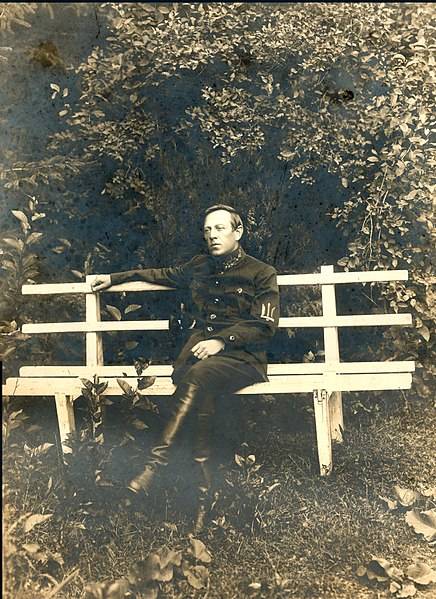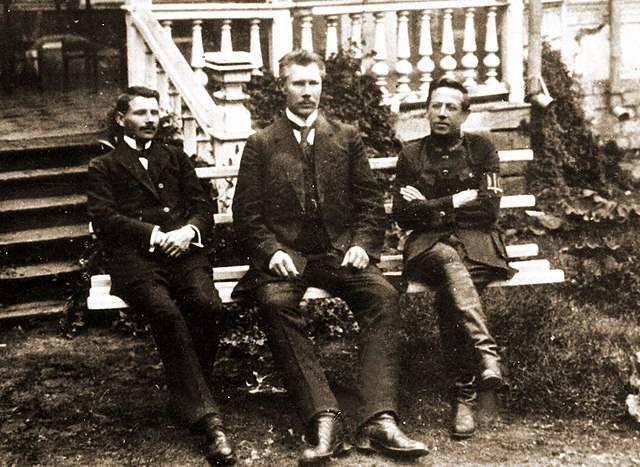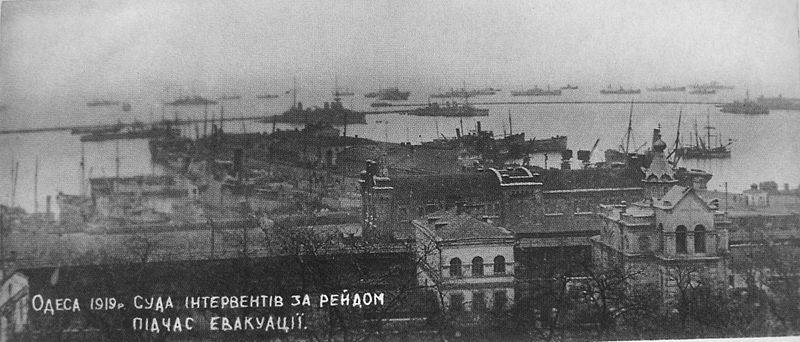How Petliurists led Little Russia to a complete catastrophe
Directory and its defeat
Having seized power, the Directory of the initial principle tried to go on the left, in the interests of the workers and peasants. Decisions were taken against the landlords, the bourgeoisie and the old bureaucracy. December 26 The 1918 was formed by the government of the Social Democrat V. Chekhovsky. The Declaration of 26 December restored the legislation of the Central Rada, planned to restore democratically elected local governments, created cultural-national autonomy for national minorities, restored the 8-hour working day, promised workers control at enterprises, state administration of leading industries and the fight against speculation.
In the course of the agrarian reform, it was planned to withdraw state, church and large private lands for their redistribution among the peasantry. It was announced that the landlord’s land would be seized without ransom, but the expenses for agrotechnical, ameliorative and other works were compensated, the landowners were left with their houses, purebred cattle, vineyard, etc. The confiscations were not subject to the land of foreign nationals, industrial enterprises and factories. Up to the full resolution of the land issue, the Directory reported that all small farms and all labor farms remain intact in the use of the previous owners, the rest of the land goes into the possession of landless and land-poor peasants, and first of all those who fought with the hetman regime. That is, the land issue was not resolved completely. Everybody was offended — by the landlords, the bourgeoisie, and the peasants. And the Bolsheviks, who had already given up the land without any delays and references to the future parliament, seemed preferable to the peasantry. Therefore, the peasant war in Little Russia continued.
The government planned to hold elections to the Congress of the working people. The peasants had to choose delegates at congresses in provincial cities, workers from factories and enterprises (then they were assigned a fifth of the seats). The intelligentsia could participate in the elections with its “labor” part (employees, educators, health care workers, etc.). The bourgeoisie was deprived of voting rights. Congress was to receive the rights of the supreme power before the convocation of the Constituent Assembly, which they were going to gather after the end of the war. In reality, local authority passed to those who had more armed fighters - to atamans. But the supreme power was in the headquarters of the Sich Riflemen, with whom he found a common language and Petlyura. The military (Petliurists) bested everything, canceled the assembly, introduced censorship, etc.
As a result, the Directory and the government played only the role of a screen for the new military dictatorship. And in January, 1919, when the war began with Soviet Russia, the military dictatorship was framed - Petlura was appointed chief ataman. Petliurists, as before, and the hetman of Skoropadsky, tried in the first place to create a new army of the UNR. If the hetman made the main stake on the cadres of the former Russian tsarist army, then Petlyura and his supporters based on the gangs of the already noted field commanders and atamans. The peasant army, which helped topple the Skoropadsky regime, was dismissed. Atamans and daddies established their personal dictatorship on the ground and did not intend to coordinate their policies with the Directorate and observe any democratic principles. It turned into a new wave of arbitrariness, violence, atamanism and chaos. Even more than before, various negative manifestations of unrest flourished - raids, robberies, requisition, extortion and violence. Rumbled bandits robbed the rich, who fled to Kiev from all over Russia. To punish the bandits, in fact, no one could.
In general, the policy of creating the Ukrainian army from field units (gangs) failed. When the offensive of the Red Army began, some atamans went over to the side of Soviet power. For example, Ataman Zeleny (Daniel Terpilo) in 1918 fought against the Germans and supporters of the hetman, created the Dnieper rebel division, supported the uprising of the Directory and helped the Petliurists to take Kiev in December, and in January 1919 broke with Petlyura, and spoke against the Directory on the side Reds, his division became part of the Ukrainian Soviet Army (in March, 1919, he spoke out against the Bolsheviks). Other warlords knew how to rob and arrest ordinary people, but they did not know how to fight and did not want to. Therefore, the UNR army had low combat capability and quickly crumbled, fled when the Red Army began an offensive at the beginning of 1919.
In contrast to the regime of hetman, generally indifferent to Ukrainization, Ukrainization has reached a new level. There was a massive replacement of signs in Russian (sometimes just shipped the letters). The support of the Ukrainizers were the soldiers who arrived from Galicia. Petliura showed adherence to the “national idea”, in January his decrees were issued on expulsion from the UNR of her enemies noted in agitation against the Ukrainian authorities, on the arrest and trial of citizens who wear epaulets of the royal army and its awards (except for St. George's crosses), as "The enemies of Ukraine."

Chief Ataman of the UNR Army Simon Petlyura in Kamenetz-Podolsk. 1919 year

Directors of the UNR F. Shvets, A. Makarenko and S. Petlyura. 1919 year
Petliurists crushed the residence of the Kiev trade unions, dispersed the Soviets. This intensified the conflict situation, multiplied the number of opponents of the Directory. In the east of the Ukraine, the supreme power was in the hands of the military command under the command of Bolbochan, as well as before the defeat of the hetman. He dispersed the local council and the trade unions. It is not surprising that in the east of the country, the masses of the people who were not inclined to support Ukrainian nationalists before, quickly became enemies of the Directory and Petliurists. Thus, the folding of the Petliurists' regime and the ataman oblast (the power of the field commanders and their gangs) almost immediately caused resistance on the ground, directed against the Directory and the UNR political camp as a whole. Smoot in Little Russia (Ukraine) flamed with a new force.
In early January, 1919 broke out a rebellion against the Petliurists in Zhytomyr. He was suppressed, but rebellions and riots continued to flare up here and there. In January, the All-Ukrainian Council of Peasant Deputies spoke out for the power of the Soviets.
All this happened against the backdrop of ongoing economic catastrophe and traffic collapse. The directory failed to stabilize the economy. Left-radical statements and actions continued the collapse of the administrative apparatus, led to opposition and the flight of industrialists, specialists and managers. Coal mining has plummeted, fuel hunger has escalated. Many industries have either practically collapsed, or have been severely degraded. Even the food industry (traditionally strong in the Ukraine), including the production of sugar, was in disrepair. Trade degraded. The situation of the urban population has deteriorated sharply, thousands of workers, fleeing from starvation, fled to the village, where else it was possible to somehow exist at the expense of subsistence farming.
At the congress of the Ukrainian Social-Democratic Party (USDRP) 10 - 12 in January 1919, the left proposed to establish the power of the Soviets in Ukraine, to begin socializing the economy, reconcile with Soviet Russia and participate in the world revolution. The position of the transition to Soviet power (but without the dictatorial methods of the Bolsheviks) was also supported by the head of the government, Chekhovsky. The slogan of Soviet power was popular among the people and the Directory wanted to intercept it. However, the right wing of the party led by Petliura, Mazepa and others sharply spoke out against Sovietization of power. Vinnichenko hesitated, but not wanting to split the Directory, did not support his leftist supporters. Thus, in general, the party supported the idea of parliamentarism and the convening of the Labor Congress. The left minority (“independent”) split off, created their own Ukrainian Social Democratic Workers Party (independent), and then took part in the creation of Ukrainian communist parties.
Ukrainian Social Democrats hoped that the situation would be normalized at the Labor Congress, which was supposed to proclaim the reunification of Ukraine. During the collapse of the Austro-Hungarian Empire in the territory of Galicia, the West Ukrainian People’s Republic (ZUNR) emerged with its capital in Lviv. It was headed by the General Secretariat K. Levitsky. The formation of the Galician army began. Ukrainian nationalists immediately grappled with the Poles, who considered Lviv and all of Galicia an integral part of Poland. So, in November 1918, the Ukrainian-Polish war began. The Poles fought off Lviv and the leadership of ZUNR fled to Ternopil. At the same time, Romanian troops appeared in Bukovina, and Czechoslovakia appeared in Transcarpathia. 1 December 1918, the delegates of the ZUNR and the UPR signed an agreement to merge both Ukrainian states into one. In early January, 1919, the treaty was ratified by January and 22, on the eve of the Labor Congress, in Kiev, the union of the Ukrainian People's Republic of ZUNR was solemnly announced. ZUNR was part of the UPR on the rights of broad autonomy, and was renamed the Western Region of the Ukrainian People's Republic (ZOUNR). ZUNR President E. Petrushevich became a member of the Directory. But until the Constituent Assembly was convened, the Western Region remained de facto independent and continued fighting with Poland and Czechoslovakia. This made it difficult for the Directory to establish links with the Entente. Galician army in January 1919, tried to attack in Transcarpathia, but was defeated by the Czechs. In February - March 1919, the Galician army was defeated by the Polish troops.
Relationships with the Entente at the Directoire were complex. During the fall of the hetman regime and the beginning of the evacuation of the Austro-German troops from Little Russia, the landing of the Entente began in Odessa. Here the main role was played by the French. The Petliurists, not daring to enter into conflict with the great powers, cleared the area of Odessa. At the beginning of 1919, the invaders took control of Kherson and Nikolaev. The Allied Command, using the strategy of "divide, punch and rule," began to support Denikinians, who professing the idea of "united and indivisible Russia", were hostile to the Petliurists. A rifle brigade of General Timanovsky (as part of Denikin’s army) is being formed in Odessa. And the ataman Grigoriev (under his command was a whole rebel army), who formally obeyed the Directory and was the owner of the Kherson-Nikolaev region, fought with white volunteer units and was against concessions to the invaders. As a result, the concessions to the interventionists from the Directory led to the fact that at the end of January 1919, Grigoriev declared war on the Directory and went over to the side of the Soviet troops.

Vessels of invaders on the roads and in the port of Odessa in the days of evacuation
8 January 1919, the directory passed a land law. Private land ownership has been abolished. The land was transferred to the use of the owners with the right of transmission by inheritance to those who process it. A land maximum was established in 15 tithes with the possibility of increasing this area by land committees if the land was recognized as low-fertility (marsh, sand, etc.). With the consent of the land committee, the owner could transfer the plot to another. Excess land was subject to redistribution, but before that it was necessary to examine this issue. The land of sugar, distillery and other enterprises was not subject to withdrawal.
The assembled Labor Congress (more than 400 delegates, the majority belonged to the Social Revolutionary Party) generally could not reverse the crisis situation. The Socialist-Revolutionary Party was split, therefore the Social Democrats dominated the congress (their main positions then coincided with the Social Revolutionaries). At the same time, the Red Army, with mass support in the east of the Ukraine, was rapidly approaching Kiev. And the power of the Directory, as previously the hetman, was already limited to the capital district, in the province rulers, field commanders with their own gangs. And their power was mainly expressed in arbitrary arrests, violence and arbitrary robberies. Therefore, 28 January 1919, the Labor Congress urged to prepare parliamentary elections and retained power over the Directory. After that, the delegates hurriedly went home, and the February 2 Directory fled to Vinnitsa.
Thus, the power of the Ukrainian Social Democrats, nationalists (Petliurists) and local atamans led Little Russia to a complete catastrophe. It is not surprising that the Red Army took power again in Ukraine comparatively easily. On many points - Ukrainization, the intervention of external forces interested in the destruction of the Russian world, the criminal revolution with the power of field commanders-atamans, the collapse of the economy, the savagery of the population, civil war, etc. - we see a complete analogy with modern events. History punishes for not knowing the lessons.
- Alexander Samsonov
- Smoot. 1919 year
How the British created the Armed Forces of the South of Russia
How to restore Soviet power in Ukraine
Information